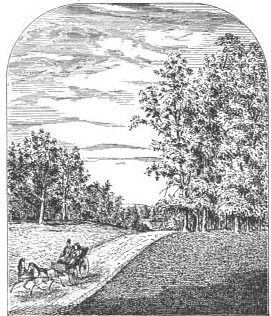
Comments by Bob Corbett
June 2004
There are a number of photos from this book below the comments.
Given that the book is anonymous, and issues by the “Visit to St. Louis” Committee, one doesn’t come to this little book of 73 pages expecting much serious history. And one doesn’t get anything like the serious and detailed history of
Caroline Loughlin and Catherine Anderson’s book
But, this is a useful little book with some nice photos a number of them which I append below, a sort of gallery which makes this book useful.
I kept my own eye out for passages in these treatment of Forest Park which especially related to the Dogtown / Cheltenham are on Forest Park’s southwest side. Two early passages caught my eye and along the way a few other things were worthy of note:
While this is a small book, it did have a number of photos, and some struck me as lovely and worthy of reprodution here:

"The sheep, so necessary for the grazing of extensive parks, will here find a retired home."
Illustration and text from the first annual report of the Commission of Forest Park, 1875.
The text points out that the use of the sheep was along the southwestern part of the park,
the part that borders Dogtown.

Illustration from the first annual report of the Commission of Forest Park, 1875.
Note that this photo emphasizes that in the early years of the park it wasn't really avaialble to people without horse transportation.
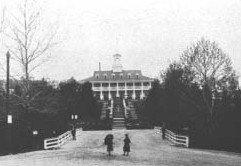
"The College" A restaurant in southeastern Forest Park fifty years ago (1890s), very popular with cicyclists in the Gay Nineties.
Note too that the key bicycle path in the early park ran from Kingshighway out to Hi-Pointe where there was no other road.
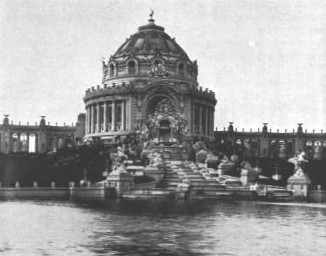
"Festival Hall and the Pavilions rose high from the water's edge"
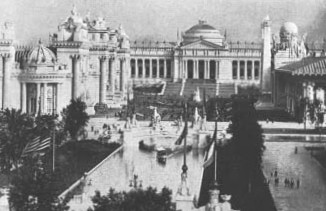
Looking toward Government Building
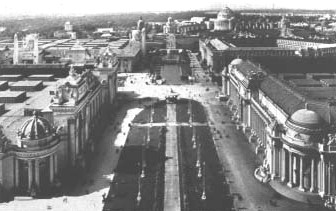
View from the De Forest Wireless Telegraphy Tower, showing the Plaza of Orleans in foregrund, with Liberal Art Building to left and Manufactures Building to righ
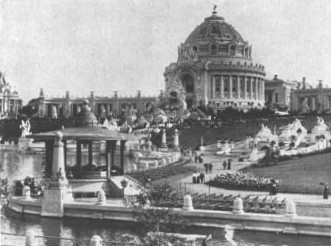
"The Cascades" With Festival Hall in the background

Westward view from the east end of Art Hill
Ten years after the St. Louis World's Fair, Forest Park was the scene of another important celebration of anniversaries: the sesquicentennial of the founding of St. Louis, and the fortieth anniversary of the acquisition of the park itself. This commemorative event, the Pageant and Masque of Saint Louis, was held at Art Hill on May 9.8, 29 and 30, and June 1, 1914, the vast audiences occupying the hillside, and the production being staged on the lagoon below.
The Pageant presented the early history of our metropolitan St. Louis, beginning with the Mound Builders: those prehistoric Americans from whose mute monuments of a mystic past St. Louis acquired the name of "The Mound City." During two hours of magnificent panorama, the characters in the Pageant's mighty cast of fifty-six hundredMound Builders, Indians, Spanish, French, English, Americans: all in costumes historically correct-played their parts in this gripping drama of St. Louis life up to the conclusion of the War between the States. The hillside audiences, each of from one hundred thousand to one hundred eighty thousand people, sat spellbound through those late May afternoons; then sunset, twilight, and evening stars. Above and behind the multitude, the benedictory gesture of that great equestrian statue of St. Louis hallowed the triumph.
There was a half-hour intermission ...
The Masque of Saint Louis, which followed this historical pageant, was a symbolic spectacle interpreting our city's vital relationship to the life of our nation and of humanity. The heroic Saint Louis was portrayed as a young crusader who encountered many adventures while campaigning for the cause of civilization. A cast of eleven hundred and fifty presented this splendid allegory with all the pomp and circumstance attendant upon the majestic grandeur of its exalted theme.
The Pageant was presented in three parts, in afternoon sunshine and the dusk of early evening; the Masque, in two parts, was a night spectacle with brilliant lighting.
... Skip some...
This magnificent spectacle was presented upon the largest stage ever built: "a world site," said Percy MacKaye. The stage was constructed over the lagoon at the foot of Art Hill, and the natural slope of the hill formed the auditorium in Nature's greatest amphitheater. The stage itself had a semicircular front of eight hundred and eighty feet, and was five hundred and twenty feet wide at the back; it was two hundred feet from the footlights to background. The background itself, fifty feet high and three hundred feet long, served both as sounding-board and decorative screen. In front of this screen was the music-pit, concealing the mammoth chorus and band from the audience. Flanking both sides of the stage, were two forty-foot towers housing the concealed control system for the thousands of vari-colored lights. The Pageant scenery was a replica of river-bluffs covered with trees, shrubs and vines; in the solemn allegory of the Masque were ancient temple scenes.
... skip some ...
"The Pageant and Masque of Saint Louis, the City's history and its aspirations, were beautifully, poetically bodied forth in spectacle and drama, last week, before such audien^es as were never seen at such events before. In a mighty amphitheater more than four hundred thousand people beheld the drama on a gigantic stage projecting o---- ! lagoon, There were thousands of actors on the stage amid beautiful scenic effects. And in the silver-washed dusk, companioned by a brilliant star, the crescent moon like a lantern hung and moving slow down the purpling night, disappeared with the final scene. The effe was stupendous. It gave one the effect of soaring. There was a sense beauty in power and power in beauty through it all.
"All the city was there. It was a great demonstration of democracy idealism, of its passion for art that it could understand, of its love for i home town, its past, its future. Here was civic art in colossal splendc Poetry, music, sculpture, acting combined their effects and fused ini an incalculably effective expression of fraternalism and solidarity of a piration and purpose through the enthusiastic participation of all sor and conditions of men, women and children, all playing in a labor love. And there passed from the stage to the assemblage on the hill vibration as of the awe in joy that comes when we apprehend the beaut ful sublime in any form. The city pulsates yet with the passion the pe formance evoked.
"The pageant and masque influenced the great assemblage on foi evenings-over one hundred thousand people at a time-as with psychical ozone of exaltation, and the enthusiasm still burns in tl casual conversation of groups of people everywhere. There is a St. Lou spirit, and a fine one, evident on every hand: it is something of the pric that must come to people who have won a great victory, and the joy omnipresent that the city did grandly and beautifully a grand an beautiful thing.
"The affair was a demonstration and proclamation of an ideal supe imposed upon material achievement. The symbolism of the masqu put things of the spirit above the things grossly
selfish. Imaginatio showed the way to Love triumphant over Greed."

The Pageant from the top of Art Hill looking down and and north
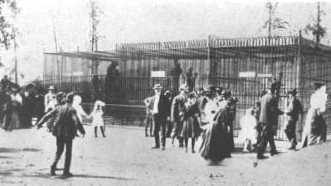
The St. Louis Zoo of other days
When it was a favorite pastime to "take the children to see the bears and monkeys in Forest Park"

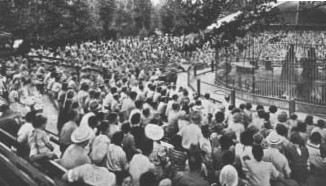
St. Louis Zoo "Cat Show"
| HOME | DOGTOWN |
| Bibliography | Oral history | Recorded history | Photos |
| YOUR page | External links | Walking Tour |